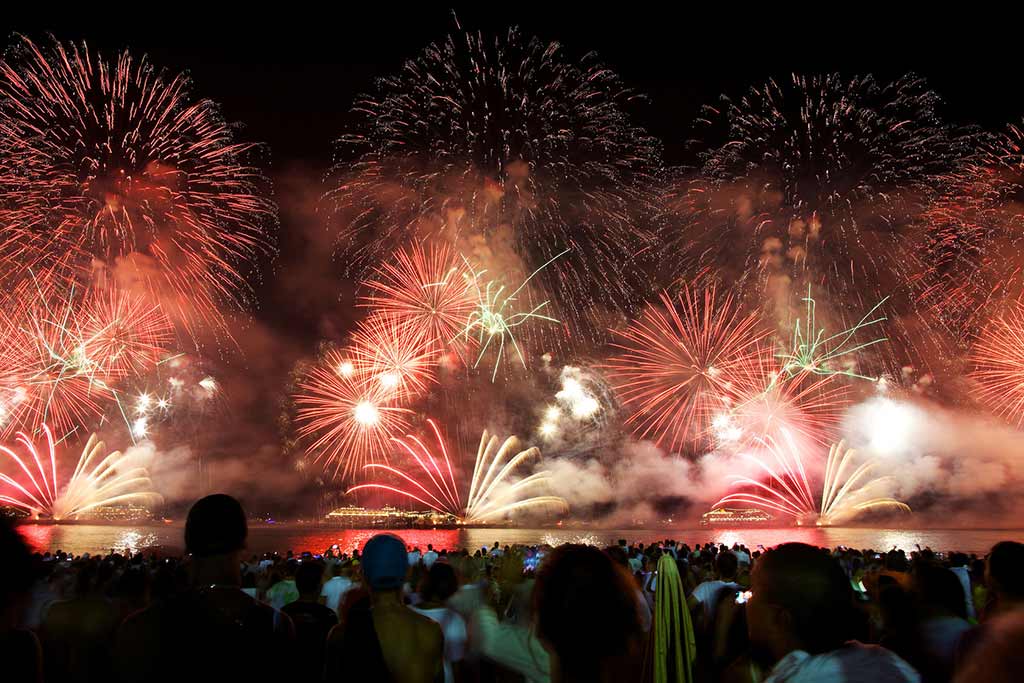While Carnaval is the most famous and well-known festival, there are many more throughout the year and throughout the country that are just as incredible to experience–some are even more spectacular than Carnaval. Whether a festa is religious or historical in nature, one thing you can count on is it’ll be a heck of a party.
Ringing in the New Year on Copacabana Beach ranks among the most magical and mystical New Year experiences. As night falls, millions of people clad in white congregate on the sands of Copacabana. The white symbolizes the purity of the new year and is also the color associated with Iemanjá, a popular Afro-Brazilian religious deity (orixá) whose title is Queen of the Seas. Revelers arrive at the beach bearing her favorite gifts: roses, perfumes, jewelry, and champagne. At the stroke of midnight, they wade into the ocean and toss their offerings into the dark Atlantic. If Iemanjá accepts their gifts, they are ensured a happy year. If the waves sweep them back to shore, better luck next time.

Fireworks display for for New Year’s Eve as seen from Copacabana Beach. Photo © Dmitry Islentyev/123rf.
Midnight also signals the start of a gigantic fireworks display and a series of open-air live music shows. Then it’s dancing and drinking the night away under the stars until morning, when everyone rings in the first day of the year (and rinses off the night’s excesses) with a dip in the ocean.
Pirenópolis is famed for having one of the most original and spectacular religious pageants in Brazil: the Cavalhadas features horsemen “dressed to represent medieval Moors and Christians, who recreate a battle fought by Charlemagne during the Crusades. The elaborate costumes are astonishingly sumptuous—the Christian cavalheiros (knights) wear scarlet, the Moors blue, and a third, more surreal group of characters, the Mascarados, wear fantastic masks fashioned out of papier-mâché. The pageantry lasts for three days and includes parades, tournaments, and a mock battle in which the Moors are vanquished (of course) and later converted to Christianity.
Of Portuguese origin and dating back to the Middle Ages, Cavalhadas have been played out in Pirenópolis since 1826 as part of a larger popular and religious festival, the 12-day-long Festa do Divino Espírito Santo, which begins 40 days after Easter Sunday. Leading up to the Cavalhadas are numerous celebrations ranging from parades and masked balls to fireworks displays. If you miss the main event, you can at least get a dose of the festivities by visiting the Museu das Cavalhadas (Rua Direita 39, tel. 62/3331-1166, 10am-5pm daily, R$2). Operated out of a private home owned by the Pina family (all of whom have historically been fervent participants), it has a splendid collection of costumes, masks, and photographs. Also worth checking out is the Museu do Divino (Rua Bernardo Sayão, tel. 62/3331-1166, 11am-5pm Wed.-Sun., R$4), housed in the former city hall and municipal prison. The small permanent exhibition breaks down the various aspects of this complex festa and whets your appetite to take part yourself. A compelling video rounds out the experience.
![Mascarados in Pirenópolis. Photo © Mauro Cruz (Own work) [Public domain], via Wikimedia Commons.](https://www.holidaytravel.cc/Article/UploadFiles/201602/2016021615015511.jpg)
Mascarados in Pirenópolis. Photo © Mauro Cruz (Own work) [Public domain], via Wikimedia Commons.
The interior’s equivalent of Carnaval, Festa de São João takes place all over the Northeast, but the biggest and most legendary celebration takes place in Caruaru (although the town of Campina Grande, in neighboring Paraíba, begs to differ). Every night, square dances, known as quadrilhas (a descendant of the ballroom quadrilles popular in 19th-century France), bring together thousands who stomp and twirl and then refresh themselves at barracas serving typical food commemorating the harvest. Most delicacies are made with corn, including pamonha, a dense corn pudding, and canjica, a creamy dessert made with white corn. Streets are decorated with colorful paper banners and balloons, and residents dress up in country-style gear with lots of plaids, ginghams, and straw hats. Caruaru’s Festa de São João is particularly famed for its bandas de pifanos—marching bands led by a fife (pifano) player, whose members don Napoleonic-style leather hats typical of the cangaçeiro).
Although the official Festa de São João festivities take place June 23-24, in Caruaru the whole month of June is one big São João celebration, with forró balls and feasting that lead up to the main event. If you plan to stay in town during this time, be warned you’ll need to book accommodations far in advance.
Excerpted from the Fourth Edition of Moon Brazil.